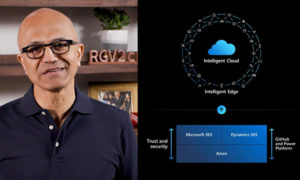
Salesforce.com and VMware jointly announced Tuesday a new platform for enterprise application development in the cloud.
They will offer application development as a service in their VMforce venture.
“[Information technology] needs to be transformed into and accessed as a service whether it’s into the corporate firewall or outside it,” said Paul Maritz, CEO and president of VMware. “We have to get people focused on what their real business is and, to do that, we have to transform the underlying architectures.
“We’re moving from Cloud One, made famous by Amazon.com, Google and eBay in simple applications that were point-and-click and managed and upgraded centrally to Cloud Two, a new type of interaction between users known as ‘social,'” said Marc Benioff, CEO of Salesforce.com. “This is a catalyst for change within the enterprise itself.”
Will the VMforce Be With Appdevs?
VMforce leverages VMware’s virtualization technologies, the Java development framework of its SpringSource subsidiary, and Salesforce.com’s Force.com cloud.
It will be offered as a service in the same way Salesforce.com’s apps are.
The use of the Spring framework will let appdevs leverage and extend enterprises’ legacy apps.
“Most companies in the world start with a very large legacy of existing applications, and it’s not economically feasible to walk away from those applications,” VMware’s Maritz pointed out. “We have to address them, so at VMware we’re building technology that lets people become more effective inside their operations and lets them function more as IT service providers within their organizations.”
The vision of offering IT as a service has been around for years, but achieving it was difficult because enterprises have vertical silos of apps that were difficult to integrate. Virtualization provides a way around this problem.
More importantly, appdevs will be able to add functionality to legacy apps and make them accessible enterprise-wide.
“To do fundamentally new things you need new applications, so we’ve been looking at new processes and new models,” Maritz explained
The Social Graces
The increasing use of social networking has changed the way people use the Internet and apps, Salesforce.com’s Benioff said. “New data types are happening on the Internet; there are new ways to do things on the Internet; and the way people are getting information is changing — they’re moving to smartphones and next-generation PCs,” he explained.
Salesforce.com calls this phenomenon mobile Internet computing.
“There’s a new type of interaction between users known as ‘social’,” Benioff pointed out. “Today we look at feeds; profiles; push instead of pull; touching, not clicking; mobile computing; smartphones and tablets; and we’re looking at new types of technology like Cocoa and HTML5 with next-generation interfaces.”
This new way of interacting is powering the drive to Cloud Two.
That, in turn, is changing the kind of apps needed in the enterprise. “Today we ask, why isn’t all enterprise software like Facebook?” Benioff said. “When we see this new generation of devices come forward like the iPad in the last few weeks, we see that developers need to change the way they develop code.”
Building Java Apps in the Cloud
VMforce will let appdevs build Java in the cloud. “Java is the No. 1 developer language in the enterprise,” Benioff said. “There are more than 6 million developers in Java.”
However, up until now, enterprise Java developers didn’t have a clear path to the cloud.
“Yes, they’ve got a great language; yes, they’ve got the scalability; yes, they’ve got the availability; but is there a gap between where Java is and where the cloud is? We believe these gaps must be filled, and that’s why VMware and Salesforce.com are coming together,” he added.
“This seems to me to be a model where the cloud is being used to provide the essential infrastructure to support the efforts of Java developers,” Charles King, principal at Pund-IT, told CRM Buyer. “It’s a broader sort of use case than we’ve seen in many cloud strategy discussions that have happened over the past few months.”
Using the Force.com platform for Java app development is five times faster and only half the cost of regular development efforts, Benioff pointed out repeatedly.
That might be a major selling point, King said. “Sure, Java developers can use the Spring development platform and collect the libraries they need on their own, but now they can aggregate the material on the VMforce site and sign in and use these resources as and when they need them,” he explained.
However, development on VMforce may not be quite as easy as it’s made out to be. “This is one of those announcements where the devil’s in the details,” King warned. “We’ll need to learn more about the pricing and availability and who the primary targets are.”
Security in the Cloud
One of the major problems with cloud computing has been the perception that security is inadequate. That perception has been fueled by repeated hacks into Facebook, Google and Yahoo, as well as repeated accidental exposure of data on high-profile platforms.
Salesforce.com’s Force.com platform offers security, reliability and scalability enterprise appdevs need, Benioff said.
That statement should be taken with a grain of salt, Bill Roth, chief marketing officer of LogLogic told CRM Buyer. “Sadly, there’s nothing that will guarantee security in the cloud,” he explained. “The technology and best practices for this are not in a state where this can be delivered.”






















































Social CRM
See all Social CRM